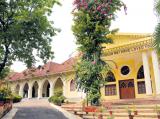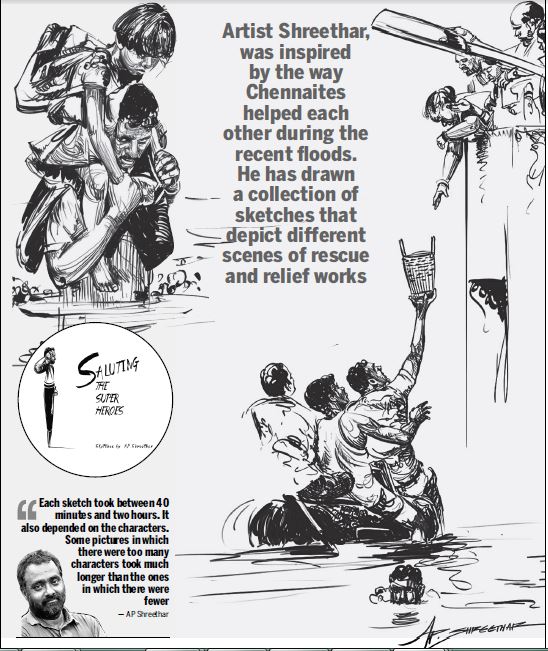Monthly Archives: December 2015
19th (24th)
23rd
22nd
21st
20th
18th
Relics of a religion
Museums
The birth of Christianity in India has been traced to the arrival of St Thomas in Kerala in 52 AD, and the religion is said to have been strengthened by the arrival of St Francis Xavier in Goa in 1542. However, there are a few museums devoted to the history of Christianity — particularly its art relics — in the country.
Successful efforts to expand the museums of Christian art are ongoing in the states of Goa, Chennai and Kerala, perhaps because of the concentration of Christians there. Other relics can be found in other corners of the country as well. Let’s go on a trail of Christian art recorded in the country…
Goa
The first attempt to shape Christianity in Goa through art was made when, in the early 1560s, on the insistence of the Jesuit missionary (in India) João Nunes Barret, the picture of Jesus on the cross (with his mother and St John standing on either sides) was printed and distributed. By the end of 16th century, the preoccupation of the Christian populace with the image increased.
Many wooden idols were painted with coloured hard wax — in red, deep blue and green, and at times, with a golden design or piping on the robe.
While most of the ivory idols were painted gold, particularly on the borders, a section of ivory models were coloured deep red using vegetable dyes. Images of Jesus as the saviour of earth, holding it in his hand, were also found in Goa, besides those of crucifixion. The Goans also developed a special regard for Virgin Mary and, in order to get her protection from disasters, they decided to carry her picture on the ships voyaging to Portugal and back.
Asia’s first exclusive Museum of Christian Art was opened at Rachol seminary in the Salcete taluka of Goa on January 24, 1994. The Calouste Gulbenkian Foundation of Lisbon, Portugal, had provided funds for this museum, and the Indian National Trust for Art and Cultural Heritage, New Delhi, provided the know-how. The museum was then moved to the annexe of the convent of Santa Monica, Old Goa.
The museum is a huge three-storeyed building of laterite that was originally lime-plastered, and later plastered with cement. Square in foundation, it comprises a large inner courtyard, around which are a verandah and numerous cells and halls.
The vaulted ceilings in some of the halls showcase finest murals that represent Christianity practised in the 17th and 18th centuries. The museum houses over 200 exhibits. Surprisingly, most of the artefacts are by Hindu artists.
According to one historian, “When idols and paintings of Christian saints became popular in the 16th and 17th centuries, newly converted Goans began to collect them. So there were not enough artists to meet the growing demand. Many Hindu artists saw a business opportunity and began producing these artworks for the market.”
Underground this oldest and largest nunnery in Asia is a wondrous basement, its ceiling covered with the most amazing frescoes. The Xavier Centre of Historical Research in Goa has also built a small museum that houses several representative items of Goan Christian art, plus palm-leaf manuscripts, medallions and a stone inscription.
Chennai
In Chennai, the sacred relics and images associated with St Thomas the Apostle are preserved in St Thomas Museum near the San Thome basilica. The small museum, started in 1985, comprises just two large halls.
The most important exhibit here is a portion of the finger of St Thomas that came in contact with Jesus Christ on Easter. This was gifted to India by the Vatican in 1952 while commemorating the 1,900th anniversary of the saint’s visit to India. According to Reverend Adaikalam, the identification of the exhibits was a task. All the treasures of Christianity had been assembled by Father Hosten, a Belgian priest of the Catholic Archdiocese, in the 1920s. It had involved meticulous research, as nearly 19 centuries had passed since the martyrdom of St Thomas, and the Portuguese had taken away a number of important relics. But Father Hosten had persisted in his labour of love and there had been a photo exhibition of these treasures in one of the museums of Vatican city, in 1925.
In the Church of Our Lady of Expectations at St Thomas Mount, there is a painting of Madonna and child Jesus, said to be painted by St Luke, one of the 12 apostles.
Kochi
A colonial structure, the Indo-Portuguese Museum of Kochi, in Fort Kochi, is the epicentre of Indo-Portuguese Christian art heritage. The museum is divided into five sections, according to the nature of items displayed — altar, treasure, procession, civil life and cathedral.
The museum houses some artistic and architectural marvels that bear the mark of a strong Portuguese influence — a piece of altar made in teak wood (16th century) and an Indo-Portuguese monstrance (18-19th century), from the Church of Our Lady of Hope, Vypeen; a chasuble (19th century) from Bishop’s House and a processional cross, which is a combination of silver and wood (17th century), from the Santa Cruz cathedral, Fort Kochi. The Coat of Arms of the Franciscans is an exhibit that stands out. But the most important artefact on display at the museum is the altar of St Francis Church, an extant piece from the 16th century.
Kerala
George Menachery, Professor of Christian Art at the Pontifical Institute, Alwaye, is the editor of the Christian Encyclopedia and Church History Classics. He plans to set up a comprehensive Indian Christian Museum.
North India
At Fatehpur Sikri, near Agra, it is said that a section of a palace built by Mughal Emperor Akbar features frescoes depicting scenes from the Bible. But more lasting have been the biblical inscriptions on the archway of Buland Darwaza (the Gate of Victory), which stands at 176 feet.
The panel of kufic script reads, “Jesus, Son of Mary (on whom be peace) said: ‘The World is a Bridge, pass over it, but build no houses upon it. He who hopes for a day, may hope for eternity; but the World endures but an hour. Spend it in prayer, for the rest is unseen’.” In Agra, the Catholic church built during the reign of Akbar has marble statues representing Virgin Mary.
Mumbai got its first Catholic museum at St Pius College in Goregaon (E) in 2011. Called Archdiocesan Heritage Museum, it houses a collection of artefacts like manuscripts, religious objects, paintings, vestments, sculptures and liturgical books. An outstanding feature of the museum is the timeline painted on one of its walls, showing the stages of Christianity in the region from AD 6 onwards.
Indeed, these ecumenical musems have become sacred houses for our cultural heritage.
source: http://www.deccanherald.com / Deccan Herald / Home> Supplements> Sunday Herald – Art & Culture / by Anthony Kuriakose / Maharaja Features / December 20th, 2015
23 Sketches on Chennai’s Bravehearts During Flood
Chennai :
He has always been knonw for his uniquely interesting sketches but now artist A P Shreethar has sketched scenes from the recent floods — especially of those who lent a helping hand to the victims and rescued many.
The artist has released a series of sketches that show common people helping each other which has become a common sighting in the city recently.
Talking to City Express, Shreethar says, “I was really touched to see the way people helped one another. I started collecting pictures of help being rendered from media personnel, and based on these pictures, I began sketching them.” The artist has sketched more than 23 pictures, two of which are his own images. Says Shreethar, “The entire set was sketched in two to three days. It took between 40 minutes and two hours to complete each sketch. It also depended on the kind of characters I was looking to draw. For instance, some pictures in which there were too many characters took much longer than the ones in which there were fewer.”
On one of his pictures, Shreethar penned the lines, ‘Saluting the super heroes’. He explains, “Thanks to TV channels, social/web media, press, army, navy, airforce, fire service personnel, police, the NGOs and all the individuals for participating and co-ordinating in relief and rescue measures. I dedicate these sketches to their brave deeds.”
Shreethar, a big fan of actor Kamal Haasan, has had his sketches released by Kamal in the past. However, this time, that isn’t the case. Ask him why and he replies with a grin, “Kamal sir is in the US at the moment. But even his fans and staff were working hard to help those affected by the recent floods.”
source: http://www.newindianexpress.com / The New Indian Express / Home> Cities> Chennai / by Manigandan K R – ENS / December 16th, 2015
LG India launches free service camp for flood-affected customers in Chennai
Chennai :
LG Electronics India will conduct a free service camp from December 15 to December 24 for all LG India customers who are affected by floods in Chennai.
The company will not charge for its services. Parts that need replacement will be offered at 50% discount.
The free service is applicable to LG customers on products that were adversely impacted by water seepage. It is valid across LG dealerships in Chennai.
“The damage and destruction is huge and we want to help people get back to normal life as soon as they can. We care for our customers and want to invest in their wellbeing,” said Vinod Kumar, head, customer service, LG Electronics India.
source: http://www.timesofindia.indiatimes.com / The Times of India / News Home> City> Chennai / by Ranjani Ayyar, TNN / December 15th, 2015

